11 changes to the rules of pro cycling that you need to know before the 2018 season
The UCI has been busy updating its rules and regulations

1. Team sizes reduced

As part of a drive to improve the safety of riders, the new UCI regulations with see the peloton limited to a maximum of 176 riders from 2018 season.
For one day races and shorter stage races, that will mean that teams will be restricted to a maximum of seven riders, while in Grand Tours they will be able to take to the start line with eight.
2. Tighter regulation of inflatable structures

In what is bad news for the Tour of Poland, the UCI has moved to bring in tighter regulations on inflatables for the 2018 season, probably prompted by Adam Yates' painful crash into a collapsed inflatable flamme rouge at the 2016 Tour de France.
For the next four years, the inflatables are covered by strict regulations, such as being equipped with two generators (one of which must be a thermic petrol generator), two blowers, secured by at least 10 anchor points, and with an "alert" technician on hand, before they are banned altogether from 2022.
3. Harsher penalties for holding on to cars
Get The Leadout Newsletter
The latest race content, interviews, features, reviews and expert buying guides, direct to your inbox!
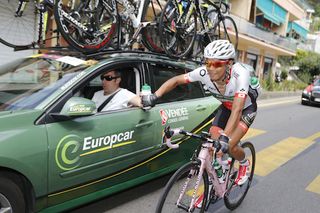
A sticky bottle has been part of cycling since time immemorial, but the UCI is trying to crack down on riders gaining an advantage by holding on to team cars with the introduction of harsher penalties.
From next season, riders found guilty could not only face a bigger fine of 200-5,000 CHF (£156 - £3900), but could also be put out of action with a ban of up to a month.
4. Harsher penalties for going through level crossings

Riders tempted to keep going through closed railway crossings will also face the same harsher penalties as those caught holding on to the side of team cars.
The most memorable such incident occurred at the 2015 edition of Paris-Roubaix when a large number of riders went across a line while the barriers were closing. Usually race organisers look at train schedules and time races to avoid such problems, but as we saw at the Ladies Tour of Norway when a slow race meant riders were forced to stop at a raised bridge, this doesn't always go to plan.
5. Clearer definition of three kilometre rule

If a rider suffers a problem in the final three kilometres of a race and wants to make sure they get the same time as the group they were in, then they need to not only make themselves known to a commissaire at the time, but also report to a commissaire after the stage.
To get the same time, they need to prove they were involved in an "incident" (as opposed to an "accident" as in the previous rules), which the UCI now defines as "any event independent from the physical capacity of the rider (fall, mechanical problem, puncture) and his will of remaining with the riders in whose company he was riding at the moment of the incident."
6. Bigger punishments for finishing outside the time limit

In the past riders have been confident that if they finished in a large group outside the time limit on a stage, they would be allowed back into the race with little more than a slap on the wrist - as was the case when 93 riders finished nearly an hour down on stage 15 of the 2016 Vuelta a España.
However from next year riders will face bigger punishments, with any riders finishing in large groups outside the time limit losing all their point from all classifications, potentially meaning the green jersey wearer could be sent back to zero points if they finish outside the time limit on the last mountain stage of the Tour de France.
7. Tighter regulation of podium ceremonies

The UCI has decided that the official award ceremonies at the end of are in need of tighter regulation, introducing a new rule to lay out the structure of ceremonies.
For one-day races the order must be the first three riders of the race, followed by winners of other optional classifications, followed by leader of UCI competitions. While for stage races there are a couple more steps to make sure fans get to see the top three riders on GC at the end of a race.
8. Riders cannot wear leaders' jerseys on opening stages

In the past, champions of various stage races have been allowed to wear the leader's jersey in the opening stage of the following year's event.
However the UCI clearly thinks that those jerseys need to be earned on the opening day of each race, with a ban on leaders' jerseys or "distinctive signs" on the first stage of a race.
9. Compensation for riders cleared of doping offences

The UCI regulations provide to articles for a model contract between riders and teams, and for the first time says that contracts should include compensation for the rider if they are fired by their team after being suspended for an offence for which they are later cleared.
In the past teams had been able to terminate contracts without notice or liability for damages in the event of serious misconduct, which can also include the rider refusing to take part in races.
10. Solo winner's support cars cannot cross the finish line

While the vast majority of team cars have to follow the race deviation, sending them off the course shortly before the finish line, in the past the sports director of a solo victory had been able to drive through the line shortly after their rider.
However for 2018 this privilege is removed, with winning sports directors having to follow the same route as every other vehicle apart from those of the event management, commissaires, and the race doctor.
11. Teams need to plan special kits further in advance

In the past if a team wanted to use a special kit, such as if Team Sky wanted to celebrate winning the Tour de France with a special yellow kit on the final day, then they'd have to decide that they were going to win 21 days in advance.
Now they have to decide that they're going to win it 60 days in advance of the start of the race, although they do at least get an answer within 30 days of the start of the event, something that was not in the rules previously.

Thank you for reading 20 articles this month* Join now for unlimited access
Enjoy your first month for just £1 / $1 / €1
*Read 5 free articles per month without a subscription

Join now for unlimited access
Try first month for just £1 / $1 / €1
Henry Robertshaw began his time at Cycling Weekly working with the tech team, writing reviews, buying guides and appearing in videos advising on how to dress for the seasons. He later moved over to the news team, where his work focused on the professional peloton as well as legislation and provision for cycling. He's since moved his career in a new direction, with a role at the Department for Environment, Food and Rural Affairs.
-
 'In three weeks there can be a lot of surprises' - Tadej Pogačar says no room for complacency ahead of Giro d'Italia debut
'In three weeks there can be a lot of surprises' - Tadej Pogačar says no room for complacency ahead of Giro d'Italia debutSlovenian labelled the favourite for overall victory in Rome, but expecting a big challenge from Romain Bardet and Geraint Thomas
By Tom Thewlis Published
-
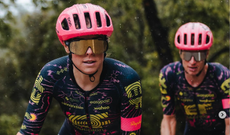 EF Pro Cycling and Rapha launch black Giro d'Italia switch out kit
EF Pro Cycling and Rapha launch black Giro d'Italia switch out kitThe American team have gone for black instead of their usual pink, in order not to clash with the maglia rosa
By Adam Becket Published
-
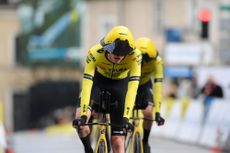 'All the conditions are met, then it's questioned again' - Visma-Lease a Bike bemoan UCI review after 'a lot of money' spent on development of Giro helmet
'All the conditions are met, then it's questioned again' - Visma-Lease a Bike bemoan UCI review after 'a lot of money' spent on development of Giro helmetTeam reacts to governing body statement on Tuesday, day after new helmet was debuted
By Tom Thewlis Published
-
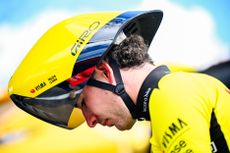 The UCI is banning time trial helmet optimisations - one day after Giro lid broke cover
The UCI is banning time trial helmet optimisations - one day after Giro lid broke coverThe 'head sock' is out, with more helmets to be reviewed - whilst hookless rim investigation is still ongoing
By Adam Becket Published
-
 UCI launches investigation into massive men's Tour of Flanders pileup
UCI launches investigation into massive men's Tour of Flanders pileupWorld governing body also investigating road-blocking team tactics used by DSM in the race as well as by Trek-Segafredo at Dwars door Vlaanderen
By Tom Thewlis Published
-
 Lefevere suggests UCI is 'short of cash' after fining Alaphilippe
Lefevere suggests UCI is 'short of cash' after fining AlaphilippeSoudal Quick-Step rails against the ruling body after his French team leader is penalised for removing his helmet while racing
By Peter Cossins Published
-
 Lava in the metaverse - Five things we want to see from a virtual Track Champions League
Lava in the metaverse - Five things we want to see from a virtual Track Champions LeagueThe competition is becoming more and more immersive, so here are a few suggestions
By Tom Davidson Published
-
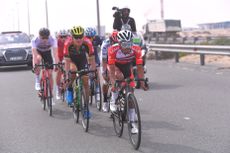 Tailwind heaven: Moroccan one-day race tops 56km/h average speed
Tailwind heaven: Moroccan one-day race tops 56km/h average speedStrong Saharan winds propel riders at Grand Prix Sakia El Hamra
By Tom Davidson Published
-
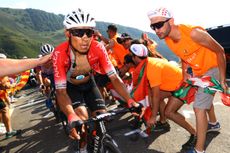 Nairo Quintana to leave Arkéa-Samsic, six weeks after signing new contract
Nairo Quintana to leave Arkéa-Samsic, six weeks after signing new contractThe Colombian is currently appealing his Tour de France disqualification
By Tom Davidson Published
-
 Nino Schurter claims astonishing tenth mountain bike world title
Nino Schurter claims astonishing tenth mountain bike world titleThe Swiss rider is considered the greatest of all time.
By Tom Davidson Published